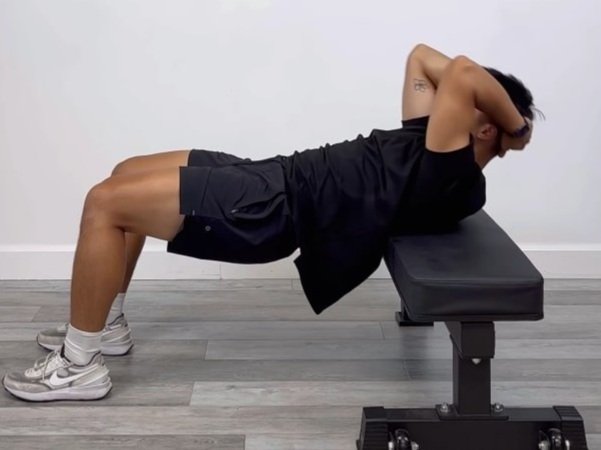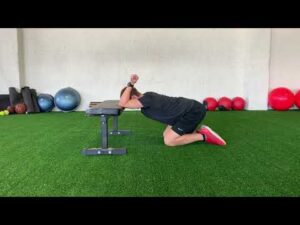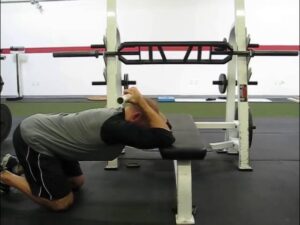

In a world increasingly dominated by screens and sedentary work, postural dysfunction has become a silent epidemic.
Forward head posture, rounded shoulders, and mid-back stiffness are now common complaints among office workers, students, and even athletes. While neck pain is often treated locally, the real culprit may lie lower—within the thoracic spine.
The thoracic region plays a crucial role in maintaining spinal alignment and supporting the head. When mobility in this area becomes restricted, the neck compensates, often leading to chronic discomfort and muscular imbalance.
One of the most effective and accessible solutions is thoracic extension on a bench. This simple yet highly targeted movement is designed to restore mobility to the thoracic spine, improve posture, and ultimately realign the neck.
In this guide, BestForwardHeadPostureFix research team shall break down how to perform this exercise correctly, why it matters, and how to avoid common mistakes.
Whether you are new to mobility work or a seasoned professional, this method deserves a place in your routine.
Table of Contents
- Introduction
- Understanding Thoracic Extensions
- Benefits for Neck Alignment
- Step-by-Step Guide to Performing Thoracic Extensions on a Bench
- FAQS on Thoracic Extensions for Fixing Neck Posture Issues
- Common Mistakes and How to Avoid Them
- Facts on Thoracic Extensions
- Conclusion
Understanding Thoracic Extensions
The thoracic spine consists of 12 vertebrae (T1–T12) situated between the cervical spine (neck) and the lumbar spine (lower back).
It is unique among spinal segments in that it connects directly to the ribcage, offering critical structural protection for organs like the heart and lungs.
This ribcage attachment, while essential for stability, naturally limits thoracic mobility compared to other regions of the spine.
However, this very stiffness becomes problematic when compounded by modern lifestyle factors such as prolonged sitting, forward-leaning posture, and lack of spinal movement.
Over time, the thoracic spine becomes locked in flexion—a hunched position that shifts mechanical load to the cervical and lumbar regions.
This rigidity disrupts the spine’s kinetic chain, forcing the neck to compensate with excessive motion during activities like head turning, computer work, or even walking.
The result is forward head posture, tight shoulders, and upper back discomfort. Thoracic extension exercises aim to counteract this imbalance by encouraging the mid-back to extend, restoring spinal curves and mobility.
Using a bench for support allows for controlled thoracic mobilization while minimizing strain on surrounding structures.
This targeted approach not only enhances spinal mechanics but also promotes better breathing patterns, scapular function, and overall postural alignment.
Benefits for Neck Alignment
Thoracic extensions offer profound benefits that extend well beyond the mid-back. These include:
- Restoring natural spinal curves: Thoracic mobility helps reestablish the normal kyphotic curve of the mid-back, which supports the cervical lordosis of the neck.
- Reducing compensatory strain: A rigid thoracic spine forces the neck to move excessively during tasks like turning the head, leading to overuse injuries.
- Relieving upper trapezius and suboccipital tension: When the thoracic spine moves better, upper-back and neck muscles don’t need to overcompensate.
- Improving head position awareness: Thoracic mobility frees the scapulae to move more naturally, which improves proprioception in the head and neck area.
Step-by-Step Guide to Performing Thoracic Extensions on a Bench:
A quick look at this very aspect explained in simple words:
Equipment Needed:
- A flat workout bench or sturdy padded surface
- Optional: PVC pipe or wooden dowel
- Optional: Yoga mat for knee padding
Setup:
- Start on your knees in front of a bench, with your knees about hip-width apart and your toes flat behind you.
- Place your elbows on the bench, about shoulder-width apart. If using a dowel, hold it with both hands and position it behind your neck or upper back.
- Keep your hips over your knees, creating a 90-degree angle. Engage your core gently to prevent lumbar hyperextension.
Movement Execution:
- Inhale deeply, then slowly sink your chest downward toward the floor. Think of bringing your sternum closer to the ground while keeping the elbows fixed on the bench.
- Let your upper back extend, creating a gentle arch through the thoracic spine. Avoid dropping your lumbar spine into an exaggerated curve.
- Hold the bottom position for 15 to 30 seconds, breathing steadily. You should feel a stretch across your mid-back, lats, and possibly your triceps.
- Exhale and return slowly to the starting position by engaging your core and bringing your torso upright.
- Repeat for 8–10 reps, or accumulate 1–2 minutes of total stretch time across 2–3 sets.
Common Mistakes and How to Avoid Them
- Overarching the lower back: One of the most common errors during thoracic extensions is letting the lower back take over the movement. Remember, the goal is to mobilize the thoracic spine—not the lumbar region. To avoid this, lightly brace your core throughout the movement. This stabilizes your lower back and ensures the extension happens where it should.
- Tilting the head backward: It’s easy to let your head drift back as you sink into the stretch, but this hyperextension in the neck can cause strain and undermine the purpose of the exercise. Always keep your neck in a neutral position, aligned with the rest of your spine.
- Letting the elbows flare too wide: Elbows that drift too far apart shift the stretch into the shoulders and away from the thoracic spine. Keep them shoulder-width to maintain focus on the mid-back.
- Forcing the range of motion: Flexibility gains take time. Pushing too far can activate muscle guarding or lead to discomfort. Stay within your natural range and allow gradual improvement.
Facts on Thoracic Extensions
- Thoracic spine mobility exercises for neck pain
This variation of bench thoracic extension is ideal for those experiencing neck discomfort due to poor mid-back mobility. - Bench thoracic extension with dowel rod
Adding a dowel can improve thoracic extension mechanics by locking the arms in place and ensuring symmetrical movement. - Thoracic extension exercises for posture correction
These extensions help correct slouched posture, especially in people with desk-bound routines. - How to improve thoracic spine flexibility
Over time, these extensions enhance spinal flexibility and allow freer, safer movement patterns. - Thoracic mobility drills for desk workers
Office employees benefit tremendously from this drill, which counteracts the effects of hunching forward for hours. - Bench thoracic extension stretch technique
Mastering technique is critical—every rep should focus on precision, control, and breath coordination. - Thoracic extension mobility for overhead athletes
Sports like swimming, tennis, or Olympic lifting require optimal thoracic extension for shoulder mobility and injury prevention. - Correcting forward head posture with thoracic exercises
Consistent thoracic mobility work often leads to visible improvements in head position and cervical spine alignment.
FAQS on Thoracic Extensions for Fixing Neck Posture Issues
Q-1: Why do bench thoracic extensions help neck alignment in the first place?
A-1: A forward head usually rides on a stiff, flexed upper back. Restoring thoracic extension gives the rib cage a better platform so the skull can sit over the torso without the neck overworking.
Bench setups let you isolate the mid–upper back while keeping a gentle chin nod, teaching the neck to stay quiet as the thorax opens—exactly the habit you want at a desk.
Q-2: What’s the simplest bench setup that targets my upper back but spares my neck?
A-2: Sit sideways on a flat bench with a rolled towel at mid–scapula level. Interlace fingers behind your head, light chin nod, elbows slightly in.
Lean back so the towel acts as a hinge under your upper back; inhale into the lower ribs, then exhale and extend over the towel, keeping the back of the neck long.
Do 6–8 slow reps, 2–3 sets, never forcing the head backward.
Q-3: How do I progress if the basic version feels easy—but I don’t want to crank my neck?
A-3: Add range and load without sacrificing alignment:
Slide the towel 1–2 cm higher or lower to hit new segments.
Hold a light plate at the sternum to cue ribs down while the spine extends.
Try kneeling bench extensions: elbows on the bench, dowel across the upper back, sit hips toward heels as you extend through the thorax—keep the chin gently tucked. Two sets of 30–45 s controlled breaths work well.
Q-4: What mistakes ruin the neck benefits—and how do I fix them fast?
A-4: Three common ones:
Head throw: eyes shoot to the ceiling. Fix: pick a ceiling spot slightly forward; keep a soft double-chin.
Rib flare: chest pops; low back steals motion. Fix: exhale, “zip” ribs toward pelvis, then extend.
Elbow splay: turns into a pec stretch. Fix: keep elbows just inside shoulder width so the hinge stays in the thoracic spine.
Q-5: How do I make bench extensions “stick” during the workday?
A-5: Pair the drill with a carryover cue: after your final rep, stand, take one slow exhale, keep the chin nod, and place screens at eye height.
Set a 60–90 minute timer; when it chimes, do 1 minute: 4 deep rib breaths with a gentle thoracic lift (hands on desk), then resume work.
For sensitive shoulders or late pregnancy, use a supported version (towel lower on the back, arms crossed on chest).
Track a weekly side photo or craniovertebral angle; if the ear sits closer over the shoulder and evening neck tension drops, your bench work is paying off.
Takeaway
Thoracic extensions on a bench are more than just a mid-back stretch—they are a cornerstone of postural rehabilitation with a direct impact on neck alignment and spinal integrity.
In a world where forward head posture and upper-body stiffness are the norm, this simple exercise offers a highly effective way to restore balance.
By mobilizing the thoracic spine, you relieve the excessive demand placed on the cervical spine, allowing your neck to return to its natural, upright position.
Over time, this can reduce tension headaches, alleviate shoulder impingement, and improve your breathing mechanics by lifting a compressed ribcage.
What makes this movement especially valuable is its accessibility. Whether you are a desk worker, athlete, or someone recovering from postural imbalances, thoracic extensions on a bench require minimal equipment and can be performed virtually anywhere.
The key lies in consistency and precision—when executed with control and awareness, they not only ease immediate discomfort but re-train your body to adopt a more functional, upright posture throughout daily life.
Incorporate this drill into your routine as a warm-up, cooldown, or daily mobility check-in. Your spine operates as a chain (impacting especially the c2 vertebrae)—if one link stiffens, the others suffer. Freeing your thoracic spine may just be the chain reaction your neck has been waiting for.
References:

